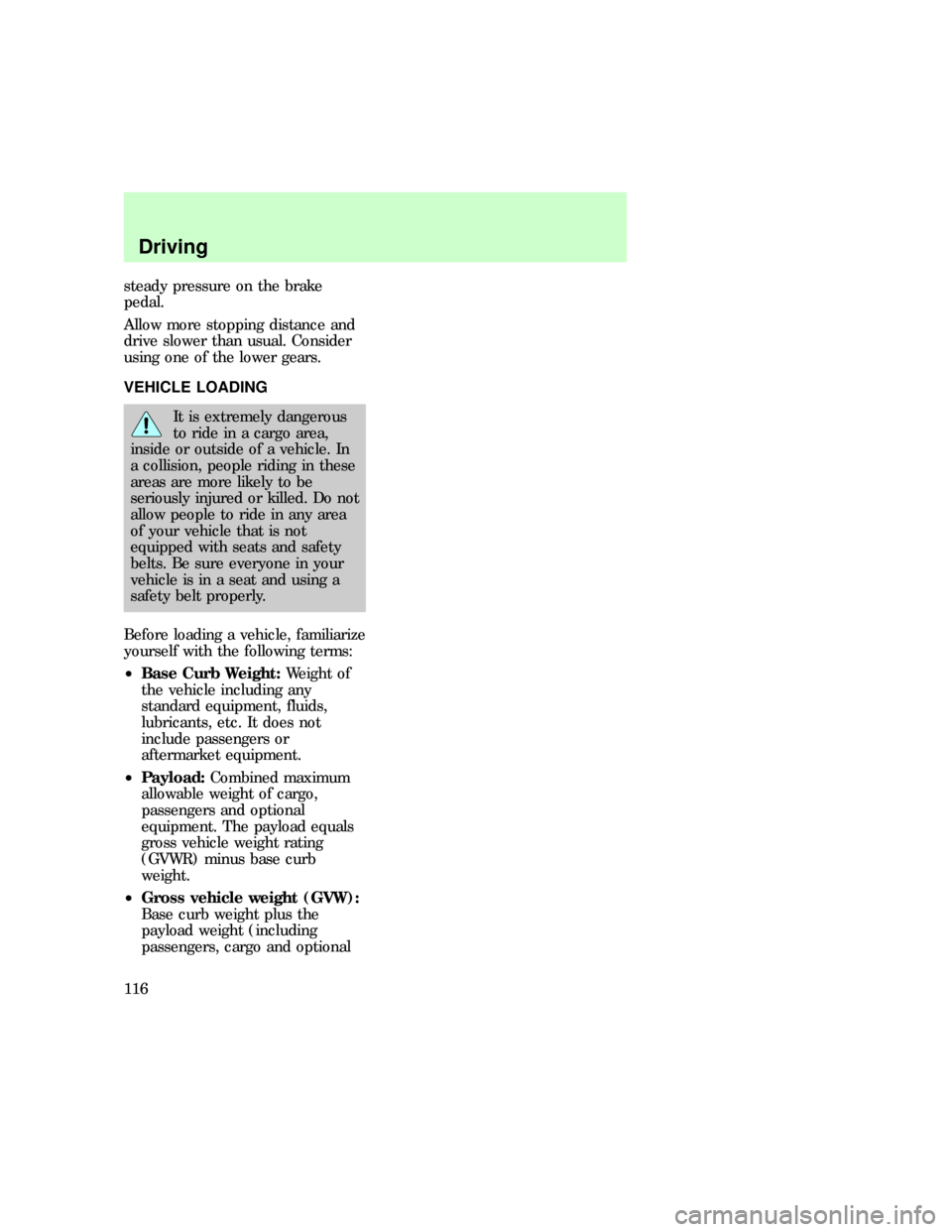Page 9 of 219

Brake system warning
Extinguishes when the parking
brake is released. Illumination after
releasing the parking brake
indicates low brake fluid level.
Safety belt
Illuminates when the ignition is
switched on to remind you to
fasten your safety belts. For more
information, refer toUsing the
safety restraints properlyin the
Seating and safety restraints
chapter.
Air bag readiness
Briefly illuminates when the
ignition is turned to On. If the light
fails to illuminate, continues to
flash or remains on, have the
system serviced. For more
information, refer to
Supplemental restraints system
(SRS)in theSeating and safety
restraintschapter.
Check engine warning light
This light illuminates when the
engine's Emission Control System
requires service. It will also
illuminate when the ignition key is
in the On position and the engine
is off. Refer toWhat you should
know about the on-board
diagnostic (OBD II) systemin the
Maintenance and carechapter.
!
BRAKE
CHECK
ENGINE
com_safety_belt.01
f12_air_bag_readiness
f12_check_engine
f12_tcil_light
Instrumentation
10
Page 115 of 219

steady pressure on the brake
pedal.
Allow more stopping distance and
drive slower than usual. Consider
using one of the lower gears.
VEHICLE LOADING
It is extremely dangerous
to ride in a cargo area,
inside or outside of a vehicle. In
a collision, people riding in these
areas are more likely to be
seriously injured or killed. Do not
allow people to ride in any area
of your vehicle that is not
equipped with seats and safety
belts. Be sure everyone in your
vehicle is in a seat and using a
safety belt properly.
Before loading a vehicle, familiarize
yourself with the following terms:
²Base Curb Weight:Weight of
the vehicle including any
standard equipment, fluids,
lubricants, etc. It does not
include passengers or
aftermarket equipment.
²Payload:Combined maximum
allowable weight of cargo,
passengers and optional
equipment. The payload equals
gross vehicle weight rating
(GVWR) minus base curb
weight.
²Gross vehicle weight (GVW):
Base curb weight plus the
payload weight (including
passengers, cargo and optional
f12_heavy_load
Driving
116
Page 157 of 219
4.2L engine
1. Battery
2. Engine oil filler
3. Engine oil dipstick
4. Clutch fluid reservoir (if
equipped)
5. Brake master cylinder
6. Power distribution box
7. Engine coolant recovery
reservoir
8. Radiator cap
9. Air cleaner
10. Power steering fluid reservoir
11. Automatic transmission fluid
dipstick (if equipped)
1
1289761110
2
3
45
Maintenance and care
158
Page 158 of 219
12. Windshield washer fluid
reservoir
4.6/5.4L engine
1. Battery
2. Automatic transmission dipstick
(if equipped)
3. Engine oil filler
4. Engine oil dipstick
5. Clutch fluid reservoir (if
equipped)
6. Brake master cylinder
7. Power distribution box
8. Engine coolant recovery
reservoir
9. Air cleaner
10. Radiator cap
10118129
1245673
f12_4.6L_5.4L_engine
Maintenance and care
159
Page 162 of 219
the MAX line, engine damage or
high oil consumption may occur
and some oil must be removed
from the engine by a service
technician.
7. Put the dipstick back in and
ensure it is fully seated.
Adding engine oil
1. Check the engine oil.
2. If the oil level is below the MIN
line, then add engine oil.
3. Remove the yellow oil filler cap.
4. Use a funnel to add oil through
the opening.
Make sure you use a certified
engine oil of the preferred
viscosity.
5. Recheck the oil level. Make sure
that the oil level is not above the
MAX line on the dipstick.
Continuous contact with
usedmotor oil has caused
cancer in laboratory mice.
f12_adding_oil
f12_brake_fluid
Maintenance and care
163
Page 163 of 219
BRAKE FLUID
CHECKING AND ADDING
BRAKE FLUID
Brake fluid should be checked and
refilled as needed at least once
each year:
²Clean the reservoir cap before
removal to prevent dirt or water
from entering the reservoir.
²Visually inspect the fluid level.
²If necessary, add brake fluid
until the level reaches MAX. Do
not fill above this line.
²Use only a DOT 3 brake fluid
certified to meet Ford
specifications. Refer to
Lubricant specificationsin the
Capacities and specifications
chapter.
Brake fluid is toxic.
If you use a brake fluid
that is not DOT 3, you will
cause permanent damage to your
brakes.
MAX
MIN
com_checking-adding_fluid.01
Maintenance and care
164
Page 164 of 219
Do not let the reservoir for
the master cylinder run
dry. This may cause the brakes
to fail.
CHECKING AND ADDING
CLUTCH FLUID (IF EQUIPPED)
During normal operation, the fluid
level in the clutch reservoir will
slowly rise. If the fluid level drops,
maintain the fluid level at the step
in the reservoir.
Use only a DOT 3 brake fluid
designed to meet Ford
specifications. Refer toCapacities
and specifications.
1. Clean the reservoir cap before
removal to prevent dirt and water
from entering the reservoir.
2. Remove cap.
3. Add fluid until the level reaches
the FULL line.
f12_clutch_fluid
f12_washer_fluid
Maintenance and care
165
Page 174 of 219
1. Park the vehicle on a level
surface.
2. Start the engine and move the
gearshift lever through all of the
gear ranges. Allow sufficient time
for each gear to engage.
3. Latch the gearshift lever in P
(Park), set the parking brake and
leave the engine running.
4. Remove the dipstick, wiping it
clean with a clean, dry rag.
5. Install the dipstick.
6. Remove the dipstick and inspect
the fluid level.
²For 4R70W transmissions, the
fluid level should be within the
crosshatched area, or if the
vehicle has not been driven,
DON'T ADD IF IN CROSSHATCHED AREA • CHECK WHEN HOT IDLING IN PARK
Maintenance and care
175